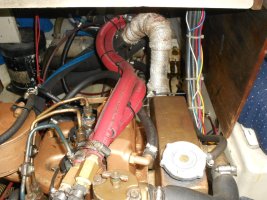sailinggreg
Member I
Hi All,
I've got a Universal Atomic Diesel model 5416 on my 1980 Erickson 30+ sailboat. I believe I've got an air gap in the coolant system.
Just replaced the heat exchanger because there was almost no seawater coming out the back. A couple years ago had the heat exchanger insides cleaned out, so seemed like it was time to replace it. A boat buddy guided me and I connected all the hoses. I refilled the coolant, started the engine and have great water coming out the back.
Unfortunately, after the engine runs about 12-15 minutes and the engine warms up, the temperature gauge then quickly goes all the way to maximum. I've run the engine at the dock three times now with the same result.
Fyi, this boat has three places where it is possible to add coolant; 1/ on the engine, 2/ in a metal reservoir and 3/ in a plastic reservoir. I'm told boats have the metal reservoir when there's a hot water tank that's higher than the engine, which is the case with my boat.
My method for filling the coolant was to fill at the engine first, then to the metal reservoir and then the plastic reservoir. After I ran the engine the first time and the temp gauge went to maximum, after letting it all cool down, I checked and was able to add more coolant in the metal reservoir. So it had drawn down coolant. Can't add more coolant directly to the engine because, since its lower than the reservoir(s), as soon as you start to open that cap coolant spills out.
I was told by a mechanic that Universal diesel engines have a plug to open to let the air out of the coolant system. I couldn't understand on the phone exactly where this is. I think he said on the top by the thermostat?
If someone could point me to this plug to let air out of the coolant system and tell me the procedure I would really appreciate it. Any other tips would be great too!
Thanks,
Greg
I've got a Universal Atomic Diesel model 5416 on my 1980 Erickson 30+ sailboat. I believe I've got an air gap in the coolant system.
Just replaced the heat exchanger because there was almost no seawater coming out the back. A couple years ago had the heat exchanger insides cleaned out, so seemed like it was time to replace it. A boat buddy guided me and I connected all the hoses. I refilled the coolant, started the engine and have great water coming out the back.
Unfortunately, after the engine runs about 12-15 minutes and the engine warms up, the temperature gauge then quickly goes all the way to maximum. I've run the engine at the dock three times now with the same result.
Fyi, this boat has three places where it is possible to add coolant; 1/ on the engine, 2/ in a metal reservoir and 3/ in a plastic reservoir. I'm told boats have the metal reservoir when there's a hot water tank that's higher than the engine, which is the case with my boat.
My method for filling the coolant was to fill at the engine first, then to the metal reservoir and then the plastic reservoir. After I ran the engine the first time and the temp gauge went to maximum, after letting it all cool down, I checked and was able to add more coolant in the metal reservoir. So it had drawn down coolant. Can't add more coolant directly to the engine because, since its lower than the reservoir(s), as soon as you start to open that cap coolant spills out.
I was told by a mechanic that Universal diesel engines have a plug to open to let the air out of the coolant system. I couldn't understand on the phone exactly where this is. I think he said on the top by the thermostat?
If someone could point me to this plug to let air out of the coolant system and tell me the procedure I would really appreciate it. Any other tips would be great too!
Thanks,
Greg



